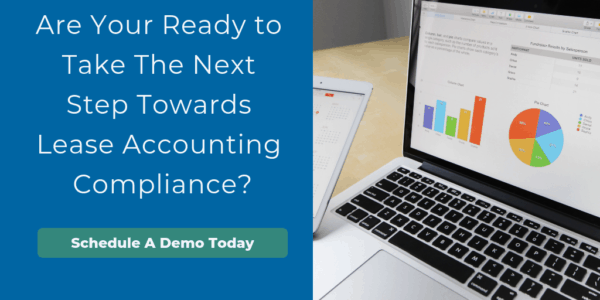
What is an embedded lease?
Simply put, embedded leases are components within contracts that entail the use of a particular asset, where the user has control over that asset. You might be surprised at some of the types of contracts that often contain embedded leases, even though the contract may not contain the word “lease.”
Accounting for Embedded Leases represents one of the trickier aspects of implementing the new FASB and IASB lease accounting standards.
In this article, we’ll review the definition of embedded leases for ASC 842 and IFRS 16. Then we’ll go over guidelines for determining if an embedded lease exists, clarifying with an embedded lease example.
The impact of embedded leases under the new standards
For organizations with hundreds to thousands of leases, the need to be ready to comply with ASC 842 and/or IFRS 16 is keeping accounting teams busy. And private companies that have not yet adopted ASC 842 and must do so by December 15, 2021, still have a big task ahead, including:
- Gathering all the necessary data about property and equipment leases
- Implementing technology to do all the calculations and create journal entries
- Deciding how to amend your policies and procedures
Complicating the problem still further is the requirement to report on embedded leases that may be found in other types of contracts, especially those with service providers.
Although you may have done some embedded leases accounting in the past, it’s now a much bigger issue because the new standards bring operating leases, and even some types of service contracts, onto the balance sheet.
That means embedded leases accounting has a much bigger impact on your income statement under the new rules. Streamline this tedious process by utilizing our lease accounting software to save time and ensure embedded leases meet the new lease accounting standards
Common areas for Embedded Leases
- Service agreements: Contracts for services may include the use of specific assets. For example, a maintenance agreement that includes the use of equipment or a service contract for the use of a photocopier.
- Supply agreements: Contracts for the supply of goods may include the use of assets. For instance, a contract to purchase goods that includes the right to use storage or warehousing facilities.
- Construction contracts: Contracts for construction or infrastructure projects may involve the use of equipment or other assets. The contract may grant the lessee the right to use specific machinery or vehicles during the construction period.
- IT contracts: Contracts for software licenses or IT services may include the use of underlying hardware assets. For example, a software license agreement that also provides the right to use specific servers or computer equipment.
- Franchise agreements: Franchise agreements often involve the use of leased premises, such as a retail store or restaurant, as well as the use of other assets, such as equipment or vehicles.
- Licensing agreements: Agreements for the licensing of intellectual property rights may include the use of assets. For instance, a licensing agreement that grants the right to use specific manufacturing equipment to produce licensed products.
- Marketing or sponsorship agreements: Contracts for marketing or sponsorship activities may involve the use of assets. For example, an agreement that provides the right to use certain advertising displays or event equipment.
Embedded leases accounting: 3 questions for identifying embedded leases
In preparation for the new lease accounting standards, you’ll need to review the content of all your existing contracts to determine if they include embedded leases.
As you review those contracts, ask the following questions to decide if they contain embedded leases and make judgments on a case by case basis with the assistance of your advisory partners.
1. Does the agreement entail the use of one or more specific assets?
If no assets are specified, then no lease can exist within the contract. However, if an asset is explicitly or implicitly identified within an agreement, then a lease may exist.
Keep in mind that a lease may exist even if not specifically labeled as a lease within the contract. For example, power purchase agreements may include the use of a specified plant. Oil and gas drilling contracts may specify the use of equipment and pipelines.
2. Does the supplier have the practical ability to substitute a different asset?
If your agreement does specify the use of an asset, can the supplier easily substitute a different asset? And would the supplier benefit economically by doing so?
On the other hand, if the asset is an office copier, it’s not likely that the supplier can easily swap out one machine for another. And it’s also not likely that the supplier would benefit financially from doing that even if they could. In that case, a lease may be present.
In an example related to real estate, today’s corporate property portfolios often include the use of co-working space. If a co-working agreement doesn’t guarantee the use of a specific space within a building (such as hot desking), then the agreement may not be considered a lease.
3. Do you have control over use of the asset?
If you have physical control and decision making authority over the use of the asset, then a lease may be present.
Real World Examples of Embedded Leases
- Office Space in a Service Contract: A company enters into a service contract with a facility management company for various services, such as cleaning, maintenance, and security. The contract also includes the use of specific office space within the facility. The right to use the office space would be considered an embedded lease.
- Equipment in a Software License Agreement: A company purchases software licenses from a vendor, and the agreement also grants the right to use specific hardware equipment required to run the software. The use of the equipment within the software license agreement would be considered an embedded lease.
- Vehicles in a Franchise Agreement: A franchisor grants a franchisee the right to operate a fast-food restaurant under their brand. The franchise agreement also includes the use of specific vehicles for delivery purposes. The right to use the vehicles within the franchise agreement would be considered an embedded lease.
- Storage Space in a Distribution Agreement: A company enters into a distribution agreement with a logistics provider to store and distribute its products. The agreement also includes the use of specific storage space within the logistics provider’s warehouse. The right to use the storage space would be considered an embedded lease.
- Manufacturing Equipment in a Licensing Agreement: A company licenses a patented manufacturing process from another company. The licensing agreement includes the right to use specific manufacturing equipment required to implement the process. The right to use the equipment within the licensing agreement would be considered an embedded lease.
Embedded leases accounting: next steps
Once you have determined which contracts do contain embedded leases according to the new lease accounting standards, what’s your next step? You’ll need to extract and get that data into a lease accounting software solution.
Learn more:
Data Collection Tips for ASC 842 Transition and IFRS 16 Compliance
Can You Trust AI for Lease Abstraction?
When implementing the new FASB and IFRS lease accounting standards, it’s easy to overlook the ongoing maintenance of your lease data. To avoid an unexpected burden on Day 2, be sure to choose lease accounting software that will make it easy to accommodate changes to existing leases and automatically update your accounting accordingly.
Questions? Let us show you how easy it is to manage your lease data and accounting in Visual Lease.
























